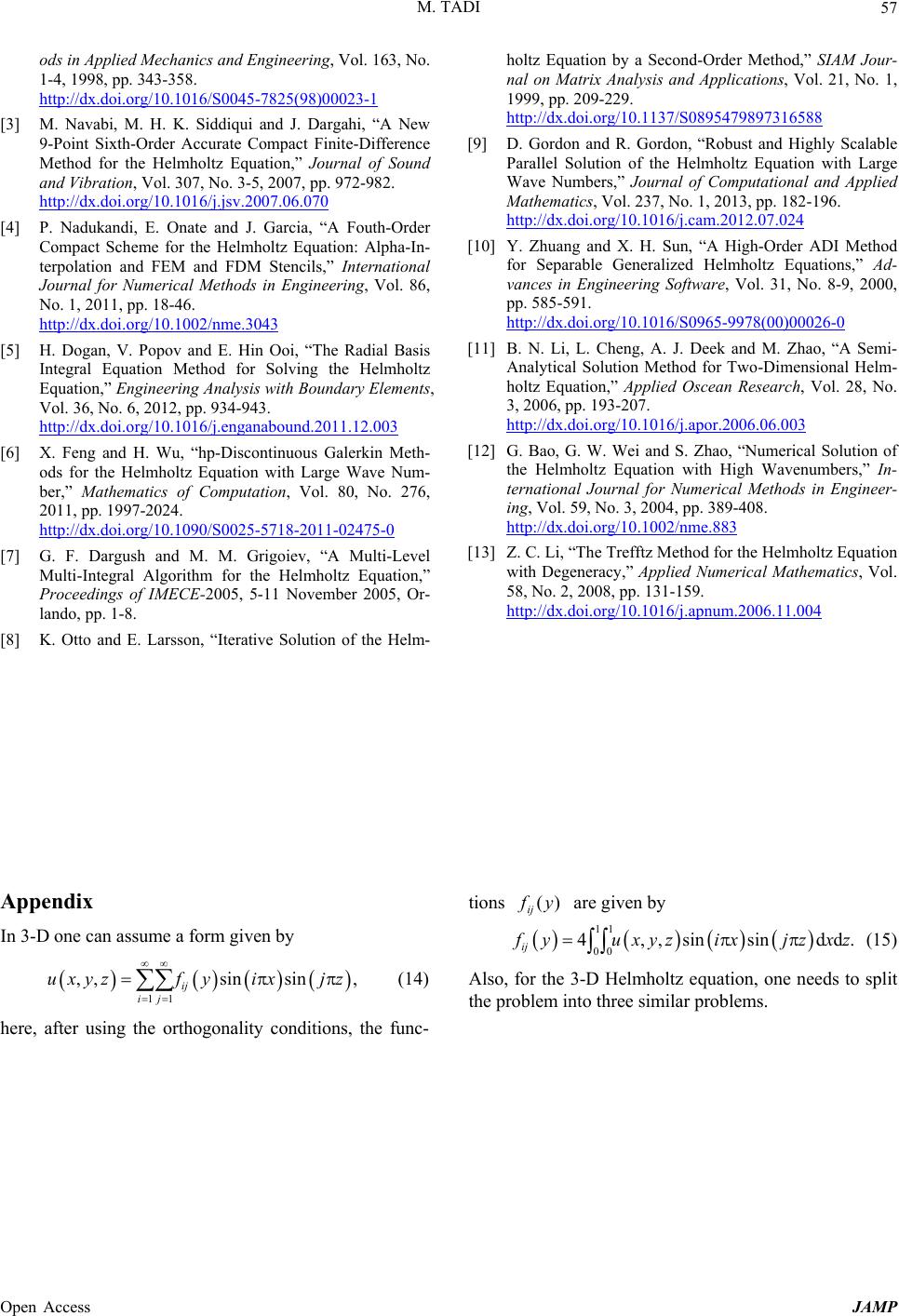
M. TADI
Open Access JAMP
57
ods in Applied Mechanics and Engineering, Vol. 163, No.
1-4, 1998, pp. 343-358.
http://dx.doi.org/10.1016/S0045-7825(98)00023-1
[3] M. Navabi, M. H. K. Siddiqui and J. Dargahi, “A New
9-Point Sixth-Order Accurate Compact Finite-Difference
Method for the Helmholtz Equation,” Journal of Sound
and Vibration, Vol. 307, No. 3-5, 2007, pp. 972-982.
http://dx.doi.org/10.1016/j.jsv.2007.06.070
[4] P. Nadukandi, E. Onate and J. Garcia, “A Fouth-Order
Compact Scheme for the Helmholtz Equation: Alpha-In-
terpolation and FEM and FDM Stencils,” International
Journal for Numerical Methods in Engineering, Vol. 86,
No. 1, 2011, pp. 18-46.
http://dx.doi.org/10.1002/nme.3043
[5] H. Dogan, V. Popov and E. Hin Ooi, “The Radial Basis
Integral Equation Method for Solving the Helmholtz
Equation,” Engineering Analysis with Boundary Elements,
Vol. 36, No. 6, 2012, pp. 934-943.
http://dx.doi.org/10.1016/j.enganabound.2011.12.003
[6] X. Feng and H. Wu, “hp-Discontinuous Galerkin Meth-
ods for the Helmholtz Equation with Large Wave Num-
ber,” Mathematics of Computation, Vol. 80, No. 276,
2011, pp. 1997-2024.
http://dx.doi.org/10.1090/S0025-5718-2011-02475-0
[7] G. F. Dargush and M. M. Grigoiev, “A Multi-Level
Multi-Integral Algorithm for the Helmholtz Equation,”
Proceedings of IMECE-2005, 5-11 November 2005, Or-
lando, pp. 1-8.
[8] K. Otto and E. Larsson, “Iterative Solution of the Helm-
holtz Equation by a Second-Order Method,” SIAM Jour-
nal on Matrix Analysis and Applications, Vol. 21, No. 1,
1999, pp. 209-229.
http://dx.doi.org/10.1137/S0895479897316588
[9] D. Gordon and R. Gordon, “Robust and Highly Scalable
Parallel Solution of the Helmholtz Equation with Large
Wave Numbers,” Journal of Computational and Applied
Mathematics, Vol. 237, No. 1, 2013, pp. 182-196.
http://dx.doi.org/10.1016/j.cam.2012.07.024
[10] Y. Zhuang and X. H. Sun, “A High-Order ADI Method
for Separable Generalized Helmholtz Equations,” Ad-
vances in Engineering Software, Vol. 31, No. 8-9, 2000,
pp. 585-591.
http://dx.doi.org/10.1016/S0965-9978(00)00026-0
[11] B. N. Li, L. Cheng, A. J. Deek and M. Zhao, “A Semi-
Analytical Solution Method for Two-Dimensional Helm-
holtz Equation,” Applied Oscean Research, Vol. 28, No.
3, 2006, pp. 193-207.
http://dx.doi.org/10.1016/j.apor.2006.06.003
[12] G. Bao, G. W. Wei and S. Zhao, “Numerical Solution of
the Helmholtz Equation with High Wavenumbers,” In-
ternational Journal for Numerical Methods in Engineer-
ing, Vol. 59, No. 3, 2004, pp. 389-408.
http://dx.doi.org/10.1002/nme.883
[13] Z. C. Li, “The Trefftz Method for the Helmholtz Equation
with Degeneracy,” Applied Numerical Mathematics, Vol.
58, No. 2, 2008, pp. 131-159.
http://dx.doi.org/10.1016/j.apnum.2006.11.004
Appendix
In 3-D one can assume a form given by
11
,,sin sin,
ij
ij
uxyzf yixjz
d
(14)
here, after using the orthogonality conditions, the func-
tions are given by
)( yfij
11
00
4,,sinsind
ij .
yuxyzixjzx
z
(15)
Also, for the 3-D Helmholtz equation, one needs to split
the problem into three similar problems.